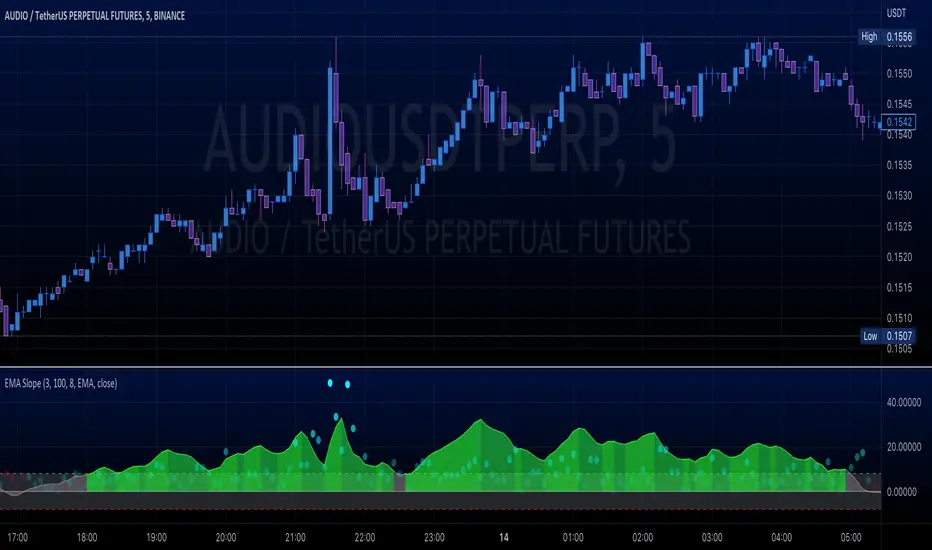OPEN-SOURCE SCRIPT
Updated EMA Slope

Release Notes
In this version just minor adjustmentsRelease Notes
Updated with some popular moving averages and source inoputs as well.Release Notes
- Added a better way to scale moving average to 100 scale. This way is better to fit with other indicators like RSI for example.- Changed MA Acceleration to line for reading purposes.
Release Notes
Small changes to make it better normalizing MA acceleration plots to last 200 bars. This will better fit in high priced assets.Changed Acceleration to circles, adding more transparency to low values.
Release Notes
Minor changes in NTZ fill color.Release Notes
Just added five alerts as suggested.EMA Slope changed to Up or Down direction
EMA Slope enters or leaves the No Trade Zone Channel.
Release Notes
Alerts will trigger only off NTZRelease Notes
The EMA slope, or Exponential Moving Average slope, is an indicator commonly used in technical analysis to identify and assess market trends. It measures the rate of change or the slope of the Exponential Moving Average line.The Exponential Moving Average is a type of moving average that places more weight on recent data points, making it more responsive to recent price changes. The EMA slope is derived from the EMA line by calculating the difference between the current EMA value and the EMA value from a certain period ago.
By monitoring the EMA slope, traders and investors can gain insights into the strength and direction of a market trend. When the EMA slope is positive, it indicates an upward trend, suggesting that prices are generally rising. Conversely, a negative EMA slope suggests a downward trend, indicating that prices are generally falling.
One important characteristic of the EMA slope is its proximity to zero. As a trend begins to lose momentum and potentially reverse, the EMA slope starts to approach zero. This means that the rate of change in the EMA line is slowing down, indicating a possible consolidation phase or a period of market indecision. This "grey zone" serves as an important visual representation of consolidation times, where the market is neither strongly bullish nor bearish.
The improved version of the indicator you mentioned likely enhances the functionality and display of the EMA slope. The improved alarms likely provide more accurate and customizable notifications when specific conditions related to the EMA slope are met, allowing traders to stay informed about potential trend changes. Additionally, the better display for the moving average acceleration likely provides a clearer and more intuitive representation of the EMA slope's behavior, enabling traders to quickly identify and interpret market trends.
Overall, the EMA slope indicator, with its ability to identify trend reversals and consolidation periods, can be a valuable tool for traders and investors in their decision-making process, helping them to better understand market dynamics and make more informed trading decisions.
Open-source script
In true TradingView spirit, the creator of this script has made it open-source, so that traders can review and verify its functionality. Kudos to the author! While you can use it for free, remember that republishing the code is subject to our House Rules.
Disclaimer
The information and publications are not meant to be, and do not constitute, financial, investment, trading, or other types of advice or recommendations supplied or endorsed by TradingView. Read more in the Terms of Use.
Open-source script
In true TradingView spirit, the creator of this script has made it open-source, so that traders can review and verify its functionality. Kudos to the author! While you can use it for free, remember that republishing the code is subject to our House Rules.
Disclaimer
The information and publications are not meant to be, and do not constitute, financial, investment, trading, or other types of advice or recommendations supplied or endorsed by TradingView. Read more in the Terms of Use.